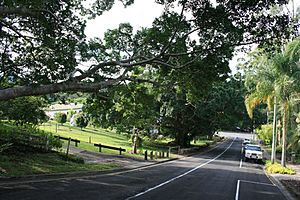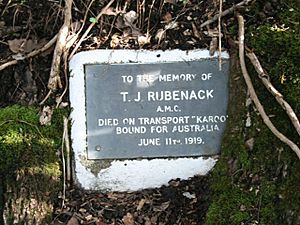Eumundi War Memorial Trees facts for kids
Quick facts for kids Eumundi War Memorial Trees |
|
|---|---|

Eumundi War Memorial Trees, 2009
|
|
| Location | Memorial Drive, Eumundi, Sunshine Coast Region, Queensland, Australia |
| Design period | 1914–1919 (World War I) |
| Built | 1917 onwards |
| Official name: Eumundi War Memorial, Trees in Memorial Drive | |
| Type | state heritage (landscape) |
| Designated | 5 December 1997 |
| Reference no. | 601122 |
| Significant period | 1914–18 (social, fabric, historical) 1979 (fabric) |
| Significant components | memorial – tree/avenue of trees, tree groups – avenue of, memorial – plaque |
| Lua error in Module:Location_map at line 420: attempt to index field 'wikibase' (a nil value). | |
The Eumundi War Memorial Trees are a special group of trees in Eumundi, Australia. They are located along Memorial Drive. These trees were planted to remember the brave soldiers from the area. They served in the First World War. The trees are also known as the Trees in Memorial Drive. This important site was added to the Queensland Heritage Register on December 5, 1997.
Contents
Remembering Our Heroes: The Eumundi Memorial Trees
The Eumundi War Memorial Trees were planted during and after the First World War. This war lasted from 1914 to 1918. Eighty-seven men from Eumundi and nearby areas joined the war. The trees were planted to honor the twenty men who sadly did not come home. The first trees were planted in a special ceremony in October 1917.
How the Trees Were Planted
The idea for the Memorial Trees came from the Eumundi Women's Patriotic Committee. People in the community donated money to help. The total cost was about £100. This shows how much the community wanted to remember their soldiers.
Why War Memorials Are Important
Before the early 1900s, there were not many statues or monuments in Queensland. But after the First World War, memorials were built in almost every town. These memorials showed the community's sadness for those who died. They also showed pride in their country. No other war has created such a strong public feeling.
The First World War had a huge impact on Australia. Almost one in five soldiers who went to war did not return. Many families lost more than one son. Some small towns lost a whole generation of young men.
In 1916, the British Government said that bodies could not be brought home. It was also very hard to visit graves far away. So, war memorials became a way for people to mourn together. They were like 'empty tombs' (cenotaphs) for those who built them. These memorials were placed in important spots. They became sacred symbols of remembrance, just like grave sites.
Queensland's Role in Remembrance
Queenslanders were leaders in keeping public remembrance alive. In 1916, they were the first state to make ANZAC Day a day of remembrance. They encouraged other states to join them. This helped make April 25 a national day to remember.
People hoped that future generations would continue this tradition. They also hoped the memorials would be respected. Sadly, some memorials have been damaged or changed over time.
What Memorials Tell Us
Memorials are important for what they represent. They also record valuable history. Many memorials list the local men who served and died in the First World War. They also share details about unveiling ceremonies and fundraising groups. This makes them very important historical documents.
Other records of soldiers are usually listed alphabetically or by army groups. This makes it hard to find where a soldier was from. Memorials are often the only easy way to find out where these brave men came from.
Unique Tree Memorials
There are many types of memorials in Queensland. But memorial drives of trees are quite rare. It is even more uncommon for each tree to represent a specific fallen soldier.
The original Eumundi Memorial Trees were fig trees. Twenty fig trees were planted. Five of these original trees are still there today. The fifteen trees that did not survive were replaced. New trees include camphor laurels, lilly pillies, and jacarandas. The first trees were planted near the railway gates and the CWA Hall. Two were replanted when the road was made wider.
When first planted, each tree had a neat white fence around it. The fence was about 6 by 6 feet. Each fence had a bronze plaque. This plaque had brass letters showing the soldier's name, army unit, and when and where they died. By the 1970s, many trees had been replaced. Many plaques were lost or damaged. In 1976, the Maroochy Shire Council replaced the twelve remaining plaques. The original plaques were then placed in the Eumundi Historical Museum.
Soldiers Remembered by the Trees
Here are some of the soldiers from the Eumundi area remembered by the Memorial Trees:
- Walter (Ted) Gridley (died July 28, 1918, France). He was the great-grandson of Joseph Gridley, an early settler in Eumundi.
- Herbert William Cooke (killed in action, Gallipoli, June 30, 1915).
- Jabez Abraham (died August 21, 1916) and Cyril Abraham (died October 20, 1918). These men were the son and stepsons of G H Cooke, a local schoolmaster.
- Aubrey Stuart-Russell (died of wounds, July 4, 1918, France). He came to the area in 1910. He was the grandson of explorer Henry Stuart-Russell.
- Frank Morgan (died October 9, 1917). He was a timber cutter before the war. His brother Bert also served and returned home.
The Trees Today
The road where the trees are located was once the main road north. Shops, hotels, and sawmills were found along it. It ran next to the North Coast railway line.
Eumundi is one of the few towns in Queensland without a large monument for the First World War. However, placing the trees on the main road makes them a central focal point. Even though traffic now uses a different route, the Memorial Trees are still important for locals and visitors.
The trees are still very important to the community. In 1977, locals suggested changing the street name from Main Street to Memorial Drive. The trees are a local landmark. They are also the main focus for the famous Eumundi Markets. These markets started in 1979. They have become a major part of the town's economy. The markets are run by the community. All money raised goes to local groups and charities.
The trees are also central to remembrance ceremonies, especially on ANZAC Day. They offer a chance for local schoolchildren to learn about history. The children often make floral tributes to place at the base of each tree.
The Maroochy Council arborist (tree expert) and the Eumundi Historical Association care for the trees and plaques.
What Do the Memorial Trees Look Like?
The Memorial Trees are found on two streets in Eumundi. Most of the trees are on Memorial Drive. This includes three figs (Ficus obliqua), three camphor laurels (Cinnamonum camphora), three lilly pillies (Syzygium paniculatum), and one jacaranda (Jacaranda mimosifolia). These are planted on the northern side of the road. On the southern side, outside the Eumundi School of Arts, are two camphor laurels.
On the western side of Gridley Street, within Clem Park, there are more trees. These include three camphor laurels, two figs, two flame trees (Brachychiton acerifolius), and one lilly pilly. Most of the trees are mature. They form a large, impressive canopy over the areas where they are planted.
Memorial Drive is the main road through Eumundi. Gridley Street runs at a right angle to it.
Why the Memorial Trees Are Special
The Eumundi War Memorial was added to the Queensland Heritage Register on December 5, 1997. It met several important requirements.
Showing Queensland's History
War Memorials show how Queensland's history has changed. They represent a common theme in many communities. They show a time of strong Australian pride and nationalism. This was especially true during and after the First World War.
A Rare Type of Memorial
Avenues of trees used as memorials are uncommon in Queensland. It is even rarer when each tree represents a specific fallen soldier. Most memorials built during or after the First World War were large monuments.
Key Features of a Memorial
The memorial at Eumundi shows the main features of a special place. It is built to remember a major historical event for a long time. It uses important symbols like avenues of trees and plaques to do this.
Beautiful and Important
The Memorial Trees and their setting are a landmark in Eumundi. They add to the beauty of the town.
Strong Community Connection
The trees are still a central point for the community. They host the markets, which are very important to the town.
The Memorial Trees have a strong and ongoing connection with the community. They show the lasting impact of a major historical event. They are also a focal point for remembering that event. They are especially important to the families of the fallen soldiers. Some of these families still live in the area.


